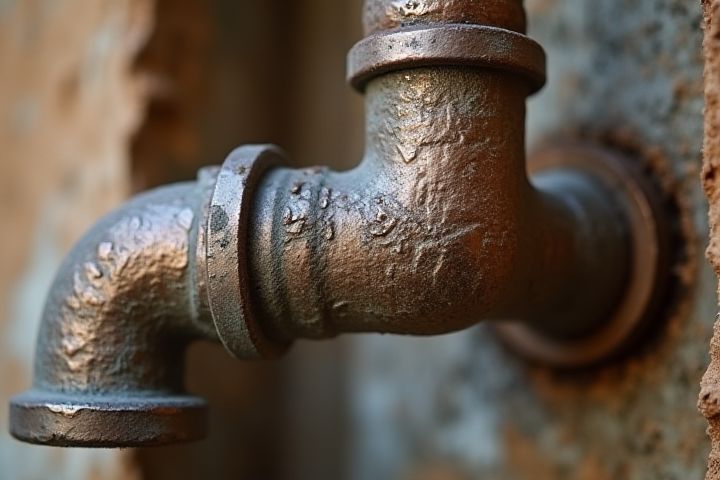
House plumbing issues are often caused by various factors, including pipe corrosion, which leads to leaks and reduced water quality. Clogged drains frequently arise from the accumulation of food debris, grease, or hair, obstructing the flow of water. Old or damaged fixtures can contribute to water pressure inconsistencies, resulting in weak water flow throughout your home. Root intrusion from nearby trees can infiltrate sewer lines, causing blockages and potential backups in your plumbing system. Lastly, fluctuations in temperature can lead to frozen pipes, which may burst and cause significant water damage if not addressed promptly.
What Causes House Plumbing Issues
Pipe corrosion
Pipe corrosion is primarily caused by chemical reactions within the plumbing system, leading to the deterioration of metal pipes over time. Factors such as water temperature, pH levels, and the presence of acids or salts greatly influence the rate of corrosion, with acidic water being particularly aggressive. In older homes, galvanized steel or copper pipes are often more susceptible to corrosion, which can result in leaks or pipe bursts and potentially cost homeowners an average of $1,500 to $3,000 in repair expenses. Regular maintenance and water quality testing can help you mitigate these issues, ensuring the longevity of your plumbing system.
Clogged drains
Clogged drains are often caused by the accumulation of debris such as hair, soap scum, grease, and food particles that adhere to the interior walls of pipes over time. Frequent use of sinks, showers, and bathtubs can exacerbate this buildup, leading to slow drainage or complete blockages. Additionally, tree roots can infiltrate underground pipes, causing significant obstructions that require professional attention. Regular maintenance, such as using drain screens and avoiding the disposal of non-soluble items, can help prevent these plumbing issues in your home.
Hard water buildup
Hard water buildup is primarily caused by high levels of minerals, particularly calcium and magnesium, present in the water supply. Over time, these minerals accumulate in pipes, fixtures, and appliances, leading to clogs, reduced water flow, and even potential damage. If left unchecked, hard water buildup can necessitate costly repairs or replacements of plumbing components, impacting your home's efficiency. To combat this issue, consider installing a water softener, which can help reduce mineral deposits and prolong the lifespan of your plumbing system.
Tree root intrusion
Tree root intrusion is a leading cause of house plumbing issues, often resulting in significant damage to underground pipes. As roots seek water and nutrients, they can penetrate cracks or joints in aging sewer lines, leading to blockages and backups. This intrusion not only restricts water flow but can also cause pipes to break or offset, creating more extensive plumbing problems that may require costly repairs. Homeowners should be aware of the warning signs, such as slow drains or foul odors, which may indicate root intrusion and necessitate prompt action to preserve their plumbing system.
High water pressure
High water pressure, typically exceeding 60 psi, can lead to significant house plumbing issues. It places excessive strain on pipes, joints, and fixtures, increasing the risk of leaks and burst pipes. This added pressure also causes faucets and appliances to wear out faster, often leading to costly repairs or replacements. It's essential to monitor your water pressure regularly and consider installing a pressure-reducing valve if measurements reveal levels above the recommended threshold.
Poor installation
Poor installation is a leading cause of house plumbing issues, often resulting in leaks, clogs, and system failures. Inadequate sealing around joints can lead to water seepage, with statistics showing that about 10% of homes experience serious leaks due to installation errors. Improperly sized pipes can restrict flow, creating pressure build-up and eventual blockages. Ensuring qualified professionals handle your plumbing installation can significantly reduce the likelihood of these costly issues arising.
Aging infrastructure
Aging infrastructure significantly contributes to house plumbing issues, often resulting from the deterioration of pipes and fixtures over time. As materials such as galvanized steel or copper corrode, leaks and clogs become common, leading to costly repairs and water damage. High water pressure combined with weak joints in older systems may exacerbate these problems, causing pipe bursts and further complications. Regular maintenance and inspection of your plumbing system can help identify potential failures before they escalate, ensuring a more reliable and efficient water supply.
Sewer line blockage
Sewer line blockages often result from a buildup of grease, hair, soap scum, and foreign objects that accumulate over time. Trees and plant roots can also infiltrate sewer lines, causing serious damage and obstructing waste flow. Regular maintenance and inspections can help detect early signs of blockage, allowing for timely interventions. If you notice slow drains or unpleasant odors, it's crucial to address potential sewer line issues promptly to avoid costly repairs.
Frozen pipes
Frozen pipes occur when the water inside your plumbing system drops to freezing temperatures, leading to ice formation that blocks water flow. This often happens in unheated areas of your home, such as basements or attics, where temperatures can plummet during winter months. Factors like inadequate insulation, drafts from windows or doors, and extremely cold weather can exacerbate the likelihood of frozen pipes. If you suspect freezing, it's crucial to address the issue quickly, as thawing can cause pipes to burst, resulting in significant water damage.
Shifting soil
Shifting soil is a significant cause of house plumbing issues, often resulting from natural phenomena such as heavy rainfall, drought, or nearby construction activities. When the soil beneath your home expands or contracts, it can exert pressure on underground pipes, leading to misalignment, cracks, or complete rupture. Studies indicate that approximately 25% of plumbing failures stem from soil movement, underscoring the importance of proper drainage systems and foundation support. Regular inspection and maintenance of plumbing systems in areas prone to soil shifting can save you from costly repairs, averaging around $1,000 to $5,000, depending on the extent of the damage.
